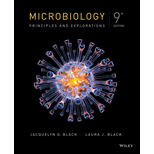
Microbiology: Principles and Explorations
9th Edition
ISBN: 9781118743164
Author: Jacquelyn G. Black, Laura J. Black
Publisher: WILEY
expand_more
expand_more
format_list_bulleted
Concept explainers
Question
Chapter 1, Problem 17SQ
Summary Introduction
To explain: The contribution of Semmelweis and Joseph Lister in
Introduction: Microbiology is a branch of science that deals with the study of microorganisms that are invisible to the naked eye. Microbiology studies about both the disease causing microbes and beneficiary microbes, about their cell biology, morphology, methods to identify, diagnose, and to culture them. The study of microbiology includes parasitology, mycology, and virology.
Expert Solution & Answer
Want to see the full answer?
Check out a sample textbook solution
Students have asked these similar questions
What is the structure and function of Eukaryotic cells, including their organelles? How are Eukaryotic cells different than Prokaryotic cells, in terms of evolution which form of the cell might have came first? How do Eukaryotic cells become malignant (cancerous)?
What are the roles of DNA and proteins inside of the cell? What are the building blocks or molecular components of the DNA and proteins? How are proteins produced within the cell? What connection is there between DNA, proteins, and the cell cycle? What is the relationship between DNA, proteins, and Cancer?
Why cells go through various types of cell division and how eukaryotic cells control cell growth through the cell cycle control system?
Chapter 1 Solutions
Microbiology: Principles and Explorations
Ch. 1 - List three reasons to study microbiology.Ch. 1 - What is the difference between microbiology and...Ch. 1 - Prob. 1.3SCCh. 1 - List five bacterial diseases and five viral...Ch. 1 - Prob. 2.1SCCh. 1 - State the germ theory of disease. Try to think of...Ch. 1 - How did Pasteurs experiment with swan-necked...Ch. 1 - Why was the French microbiologists method of broth...Ch. 1 - What were the scientific contributions of Jenner,...Ch. 1 - Prob. 3.2SC
Ch. 1 - What is the Human Genome Project? How has...Ch. 1 - Prob. 1CCSCh. 1 - Prob. 1CTQCh. 1 - Can you think of some reasons why it might be hard...Ch. 1 - As often happens in science, one observation or...Ch. 1 - It is likely that others beside Anton van...Ch. 1 - The completion of chromosomal mapping and...Ch. 1 - Prob. 6CTQCh. 1 - Prob. 1SQCh. 1 - Conclusive evidence of thriving microbial life has...Ch. 1 - Which of the following is not true? (a) A single...Ch. 1 - Which is false regarding Archaea? (a) They lack a...Ch. 1 - Why are microbes important to study and how are...Ch. 1 - Prob. 6SQCh. 1 - Prob. 7SQCh. 1 - Animals such as worms and ticks are too large to...Ch. 1 - Prob. 9SQCh. 1 - Prob. 10SQCh. 1 - What triggered the development and establishment...Ch. 1 - Prob. 12SQCh. 1 - Prob. 13SQCh. 1 - The biggest obstacle in the acceptance and...Ch. 1 - Match the following terms to the appropriate...Ch. 1 - Prob. 16SQCh. 1 - Prob. 17SQCh. 1 - Prob. 18SQCh. 1 - Describe the contributions of the following...Ch. 1 - Prob. 20SQCh. 1 - Prob. 21SQCh. 1 - Prob. 22SQ
Knowledge Booster
Learn more about
Need a deep-dive on the concept behind this application? Look no further. Learn more about this topic, biology and related others by exploring similar questions and additional content below.Similar questions
- In one paragraph show how atoms and they're structure are related to the structure of dna and proteins. Talk about what atoms are. what they're made of, why chemical bonding is important to DNA?arrow_forwardWhat are the structure and properties of atoms and chemical bonds (especially how they relate to DNA and proteins).arrow_forwardThe Sentinel Cell: Nature’s Answer to Cancer?arrow_forward
- Molecular Biology Question You are working to characterize a novel protein in mice. Analysis shows that high levels of the primary transcript that codes for this protein are found in tissue from the brain, muscle, liver, and pancreas. However, an antibody that recognizes the C-terminal portion of the protein indicates that the protein is present in brain, muscle, and liver, but not in the pancreas. What is the most likely explanation for this result?arrow_forwardMolecular Biology Explain/discuss how “slow stop” and “quick/fast stop” mutants wereused to identify different protein involved in DNA replication in E. coli.arrow_forwardMolecular Biology Question A gene that codes for a protein was removed from a eukaryotic cell and inserted into a prokaryotic cell. Although the gene was successfully transcribed and translated, it produced a different protein than it produced in the eukaryotic cell. What is the most likely explanation?arrow_forward
- Molecular Biology LIST three characteristics of origins of replicationarrow_forwardMolecular Biology Question Please help. Thank you For E coli DNA polymerase III, give the structure and function of the b-clamp sub-complex. Describe how the structure of this sub-complex is important for it’s function.arrow_forwardMolecular Biology LIST three characteristics of DNA Polymerasesarrow_forward
arrow_back_ios
SEE MORE QUESTIONS
arrow_forward_ios
Recommended textbooks for you
- Basic Clinical Lab Competencies for Respiratory C...NursingISBN:9781285244662Author:WhitePublisher:Cengage
- Essentials Health Info Management Principles/Prac...Health & NutritionISBN:9780357191651Author:BowiePublisher:Cengage
 Biology (MindTap Course List)BiologyISBN:9781337392938Author:Eldra Solomon, Charles Martin, Diana W. Martin, Linda R. BergPublisher:Cengage Learning
Biology (MindTap Course List)BiologyISBN:9781337392938Author:Eldra Solomon, Charles Martin, Diana W. Martin, Linda R. BergPublisher:Cengage Learning Principles Of Radiographic Imaging: An Art And A ...Health & NutritionISBN:9781337711067Author:Richard R. Carlton, Arlene M. Adler, Vesna BalacPublisher:Cengage Learning
Principles Of Radiographic Imaging: An Art And A ...Health & NutritionISBN:9781337711067Author:Richard R. Carlton, Arlene M. Adler, Vesna BalacPublisher:Cengage Learning



Basic Clinical Lab Competencies for Respiratory C...
Nursing
ISBN:9781285244662
Author:White
Publisher:Cengage

Essentials Health Info Management Principles/Prac...
Health & Nutrition
ISBN:9780357191651
Author:Bowie
Publisher:Cengage

Biology (MindTap Course List)
Biology
ISBN:9781337392938
Author:Eldra Solomon, Charles Martin, Diana W. Martin, Linda R. Berg
Publisher:Cengage Learning

Principles Of Radiographic Imaging: An Art And A ...
Health & Nutrition
ISBN:9781337711067
Author:Richard R. Carlton, Arlene M. Adler, Vesna Balac
Publisher:Cengage Learning
Industrial Processes and By-products | 9-1 GCSE Chemistry | OCR, AQA, Edexcel; Author: SnapRevise;https://www.youtube.com/watch?v=CMLKgqEMXwc;License: Standard Youtube License